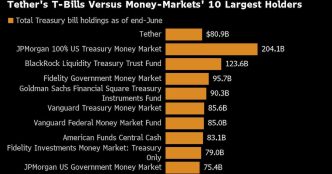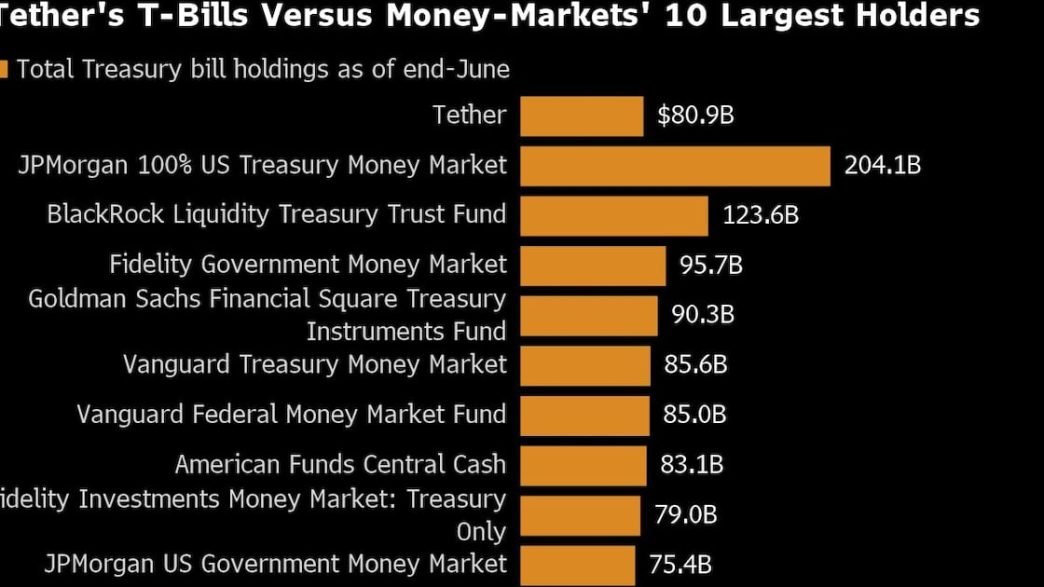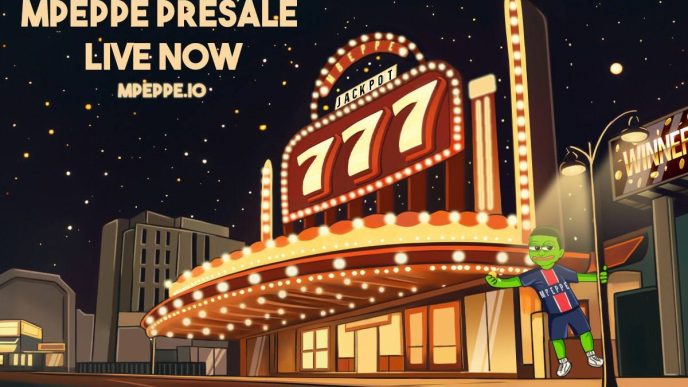(Bloomberg) — They are turning into the strangest of bedfellows in the financial world: The famously safe securities issued by the US Treasury and the notoriously not-so-safe world of cryptocurrencies.
Issuers of crypto stablecoins meant to track the dollar one-for-one have become noticeable players in the Treasury market as they seek the safest and most-liquid assets to back the value of their tokens.
For crypto promoters, it’s a development worth touting as the industry seeks friendlier relations with the US government. Tether Holdings Ltd., issuer of the largest stablecoin, has said it is able to “help support US and global financial stability” as issuance of US debt increases and foreign purchases decrease. The sector could even “stave off a U.S. debt crisis,” according to Paul Ryan, the former speaker of the House of Representatives who serves as an adviser for crypto firm Paradigm, in a June op-ed in the Wall Street Journal.
Yet like with many other topics involving crypto, there is an element of truth – and a lot of questionable hype. At least for now.
“Yes, of course it’s hype,” said Joseph Gagnon, a senior fellow at the Peterson Institute for International Economics who formerly worked at the Federal Reserve. For example, the roughly $81 billion in Treasury bills directly owned by Tether “is not trivial,” he said. “But it’s just not big by the standards of trillions of dollars in the Treasury market. I don’t see it as a big deal.”
At the moment, stablecoins are far from major whales in US debt markets, accounting for only about 1% of all Treasury bill purchases. The $6.19 trillion money-market mutual fund industry remains the largest buyer of bills. At the end of June, those funds held about $2.4 trillion of government debt, according to Crane Data. And demand from them is likely to grow as new regulatory requirements that take effect in October impose mandatory liquidity fees on some funds during times of financial stress.
There are also corporate whales in traditional finance that dwarf the Tethers of the world: Warren Buffett’s Berkshire Hathaway Inc. increased its holdings of T-bills to $234 billion in the second quarter, almost triple Tether’s holdings and accounting for about 4% of T-bill purchases. The entire market cap for stablecoins is currently about $167 billion, of which Tether accounts for about $117 billion, according to data tracker CoinGecko.
Whether stablecoin issuers do develop into major whales capable of influencing the T-bill market depends largely on how fast the crypto market itself continues to grow, and if the US Congress ever passes legislation regarding them.
The most-popular use of stablecoins is as a stand-in for the dollar in crypto markets. Traders park assets in these tokens when they want to limit their exposure to volatile crypto markets, or use them to invest in decentralized-finance platforms that lack on- and off-ramps for fiat currencies.
Yet remittances and protecting against weakening traditional currencies are also popular use cases — and a growing business. There’s already significant demand for stablecoins in emerging economies, according to an analysis conducted by the Centre for Economics and Business Research and BVNK between April and June this year. Businesses and consumers in 17 emerging markets were willing to pay an average premium of 4.7% over the standard dollar price to access stablecoins, CEBR said, with the figure rising to 30% in countries like Argentina. By 2027, the researchers estimate that those countries will pay $25.4 billion in premium alone to access stablecoins.
Demand for government debt from stablecoins could strengthen substantially, according to JPMorgan Chase & Co. strategists led by Teresa Ho, should Congress enact legislation that requires tokens to be backed at least one-to-one by high quality liquid assets, or HQLA, a category that includes Treasury bills maturing in 90 days or less.
Still, veterans of the fixed-income market are skeptical about how much the purchases will matter to the big picture. Stablecoin issuers like Tether are not going to stop yields from moving higher on the back of supply concerns and other market forces, according to Lawrence Gillum, the chief fixed-income strategist at LPL Financial who’s been working in debt markets for the last two decades. However, Treasury Secretary Janet Yellen should still be grateful for any marginal increase in demand, he added.
‘Any Buyer You Can Get’
“Given that foreign investors have stepped back, to fund deficits the Treasury is going to have to find additional buyers,” he said. “And if it turns out that crypto is a marginal buyer, then that would be a good thing for Treasury issuance. If you are Janet Yellen, you will take any buyer you can get at this point.”
Tether Chief Executive Officer Paolo Ardoino, for his part, is confident his firm will become an even more important player in Treasury securities. He believes the growth of the stablecoin market will be strong enough to make Tether, which is known as USDT, the biggest owner of three-month T-bills in the next few years, and perhaps the largest owner of all T-bills within a decade. Eventually, he expects Tether to be 100% backed by US T-bills, and only its excess reserves will be invested in other asset classes.
That Tether has become a player in the market for US government debt — and championed as a force to support US dollar hegemony — marks a stark contrast from its earlier years, when questions swirled around the mysterious digital currency dreamed up by a former child actor from The Mighty Ducks and how exactly the company was backing up the stablecoin.
In 2021, Tether, which is incorporated in the British Virgin Islands, reached a settlement with the New York Attorney General — without admitting any wrongdoing — over allegations that the company lied about its reserves and hid losses. It reached a similar settlement with the Commodity Futures Trading Commission that same year, without admitting or denying the allegations.
Yet since then, the firm has become a client of one of the cornerstones of the Treasury market: Cantor Fitzgerald LP. In 2020, Cantor Fitzgerald’s Chairman and CEO Howard Lutnick took an interest in crypto companies, according to Ardoino. “So we met, he asked us, ‘do you have the money?’ Our answers was yes. And he asked us, ‘is it OK if I check for every single penny?’”
Cantor Fitzgerald spent about two years doing its due diligence on Tether, according to Ardoino, who described it as “the deepest due diligence that someone could imagine.”
Not ‘Italian Weirdos’
“And in the end he thought, ‘well these guys that have been attacked by media for a long time and people thought they didn’t have the money, they were bad guys and so on, a couple of Italian weirdos. It happens that they have the money and actually they’re doing the right thing.’ So that’s what made him be interested in us,” Ardoino recalls.
Lutnick himself has described the process similarly in public remarks this year, saying in a speech at the Bitcoin 2024 conference last month that Tether “had every penny, but they had it in what I would call pretty god-forsaken places,” including Chinese commercial paper. Cantor Fitzgerald agreed to onboard Tether, he added, on the condition that when that commercial paper and other investments matured, Tether would send the money to the firm to buy T-bills.
“I care about the 300 million wallets that hold Tether because those 300 million wallets are financing the US Treasury’s debt,” Lutnick added. “Emerging market distribution of USDT is fundamental for backing our debt in our country, which helps us live in this beautiful way.”
Meanwhile, lingering high interest rates have made Tether’s pivot to T-bills a lucrative move that helped earn the company a record $5.2 billion in net profit in the first half of this year, according to its latest attestation report. And the relationship with Cantor Fitzgerald, which also allows Tether access to liquidity through the overnight reverse repo market, has helped erase some of the skepticism toward the stablecoin.
“That’s one of our most impressive and longstanding Wall Street firms with a great tradition of being an exceptional actor in the TradFi space,” said Matthew Graham, CEO of crypto-focused venture-capital firm Ryze Labs. “That does give me a lot of confidence.”
Still, to get a real sense of Tether’s true weight in the Treasury market, looking at total outstanding debt provides perspective. When including Treasury notes and bonds, which are coupon-bearing securities with longer maturities than bills, the US debt pile amounts to $27 trillion. Bills make up only about one-fifth of that total. The nonpartisan Congressional Budget Office projects that chronic US deficits will lift US debt to about $48 trillion by the end of 2034.
Given this backdrop, Tether’s holdings are “not nothing” but also not a game changer for funding deficits, according to Mark Sobel, a former Treasury official who’s now US chairman at the Official Monetary and Financial Institutions Forum think tank.
“I’m sure there are much bigger fish to fry for the Treasury,” Sobel said.
©2024 Bloomberg L.P.
Source link
Liz Capo McCormick, Emily Nicolle, Alexandra Harris
https://www.bnnbloomberg.ca/investing/2024/08/21/bond-market-pros-are-unimpressed-with-baby-whales-from-crypto/
2024-08-21 13:00:13














